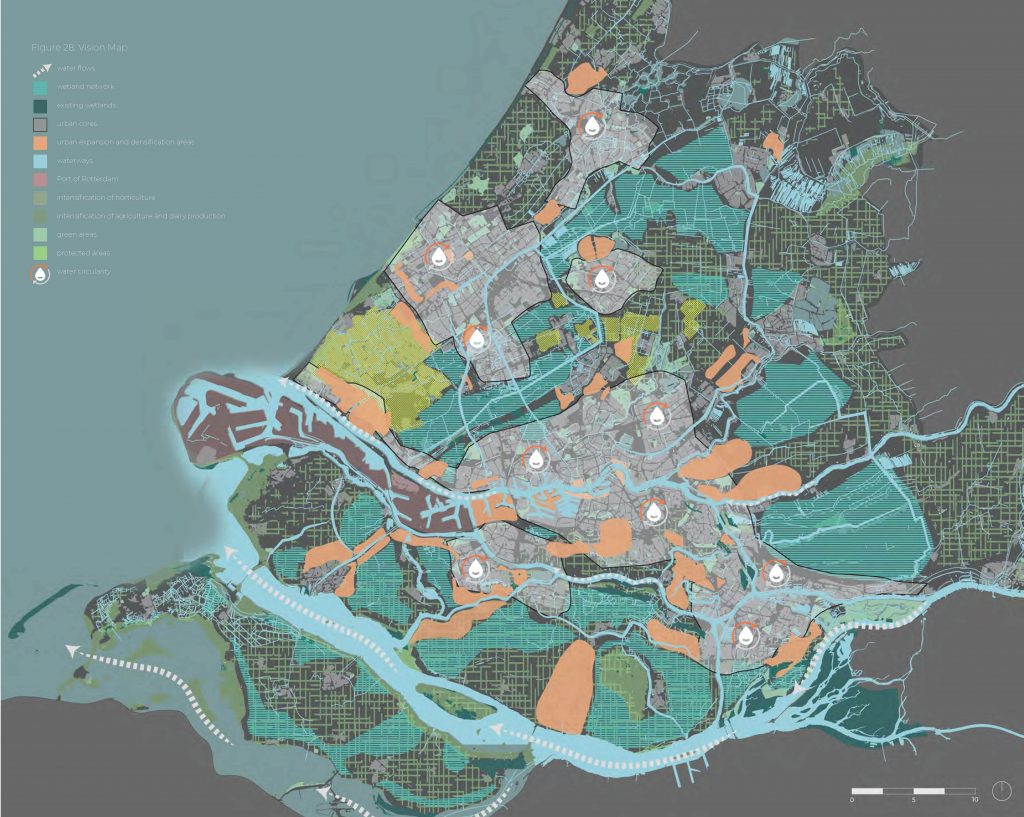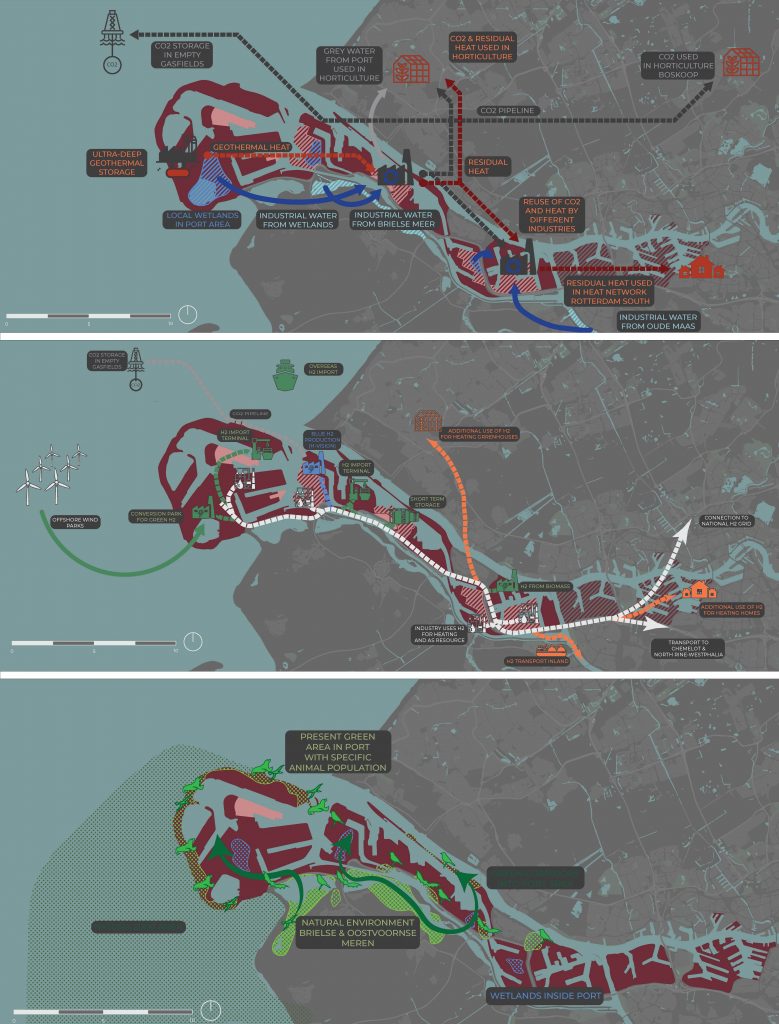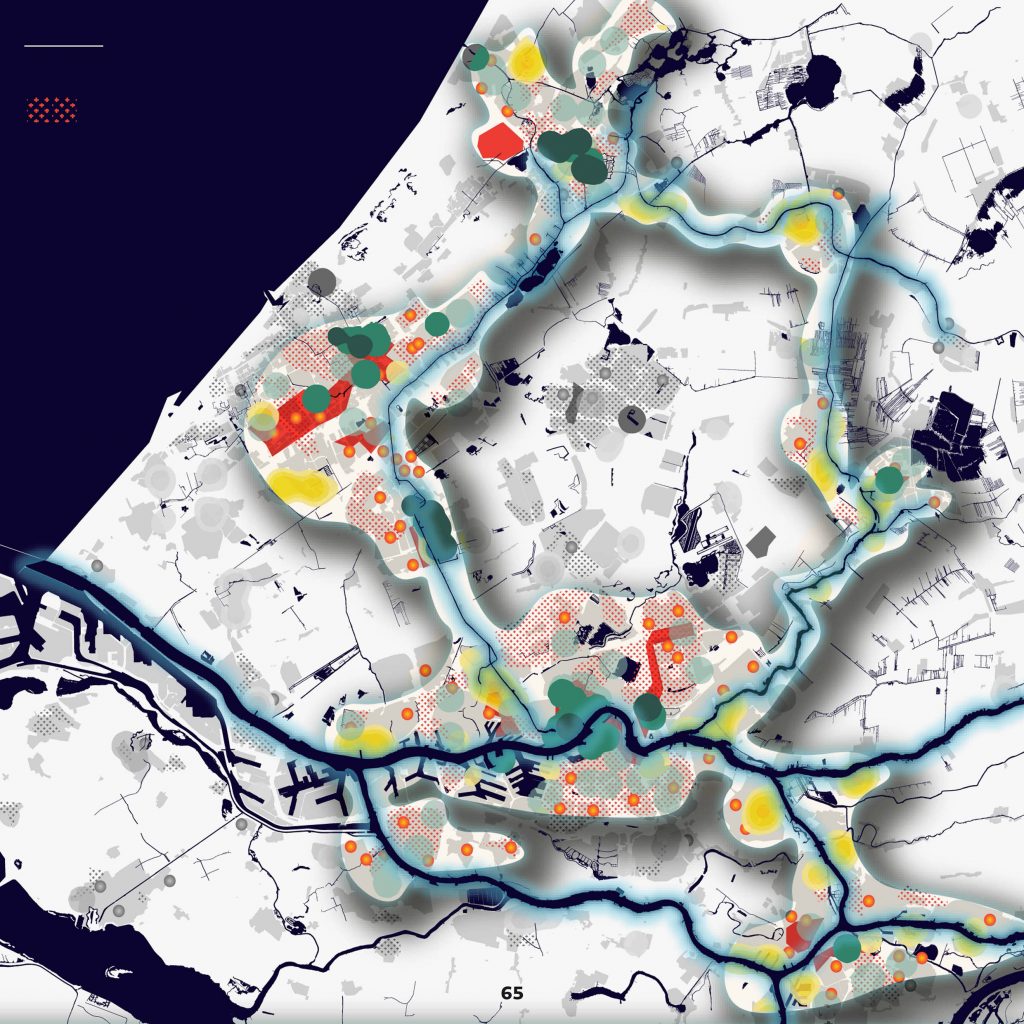The port of Rotterdam – whose freight throughput of about 470 million tonnes places it among the world’s largest ports – is currently specialised in the distribution, storage, and processing of fossil fuels’ raw materials, including crude oil, coal and liquid gas (Port of Rotterdam, 2019a). As evidenced by national and international agreements concerning the mitigation of climate change effects (European Commission, 2019; Ministerie van EZK, 2019), a pressing need to transform such activities has become obvious over recent years. The Port of Rotterdam Authority, a corporation between the municipality of Rotterdam and the Dutch national government, has consequently envisioned a series of strategic approaches towards a carbon-neutral port (Port of Rotterdam, Rijksoverheid, Provincie Zuid-Holland, Gemeente Rotterdam, & Deltalings, 2019).
Opportunities for change are seen in synergetic effects between simultaneously ongoing transitions in the realms of digitalisation, logistics, energy, and circular economy. The port’s position at the crossroads of raw material and residual flows is also associated with a future international position as a ‘waste-to-value port’ (Port of Rotterdam, 2019b). Measures to foster this position concern the treatment and distribution of bio-based raw materials, recycling, and the digitalisation of logistic infrastructures and services, for instance through the ‘internet of things’, material tracking and block chain technologies. The Port of Rotterdam Authority further envisions a staged approach towards a renewable energy system, drawing on hydrogen, solar, geothermal, and biomass sources. A more efficient use of energy (e.g. residual heat), carbon capturing and storage form early milestones in this strategy. At later stages, sustainable energy production and a circular use of materials can enhance each other in order to form one symbiotic system.
In this article we review how TU Delft Urbanism master students have considered this port vision during design experiments in order to construct a portrayal of its spatial dimension.
The Research & Design studio “Spatial Strategies for the Global Metropolis”
The Master of Science Urbanism track at the Faculty of Architecture and the Built Environment, TU Delft, is a scientific design education program characterized by interaction between thinking – analysis and reflection – and doing – or the speculative imagination of spatial interventions. The Research & Design studio “Spatial Strategies for the Global Metropolis”, which runs during the third quarter of the curriculum, has ‘regional design’ as its core theme [1]. Regional designs explore solutions to structural spatial problems that occur on high levels of scale. They allow us to critically reflect on the spatial implications of prevailing political agendas and planning regimes and can inform long-term strategic planning decisions (for an elaboration of this stance, see Balz, 2021; Neuman & Zonneveld, 2021).
The studio resembles a ‘situated learning environment’ (Wandl et al., 2019). Assignments address urgent societal problems, explore real policy agendas, and complement ongoing research. The brief of the 2020-2021 round was defined by the Province of South Holland’s ambition to host a 100% circular economy by 2050 (Provincie Zuid-Holland, 2019). Experts in the research project Resource Management in Peri-urban Areas: Going Beyond Urban Metabolism (REPAiR), funded by the European Union under the Horizon 2020 framework, contributed to the set-up and conduction of the course [2]. Researchers from Drift for Transition at Erasmus University of Rotterdam [3] and PortCityFutures [4] inspired a focus on the role of the port of Rotterdam in a South Holland circular economy. Members of the institutes supported a deeper and more comprehensive understanding of this role during lectures, discussions, and reviews.
During a period of ten weeks, 19 groups of students designed visions and development strategies leading towards a circular economy in the South Holland region [5] (for a summary of results, see Department of Urbanism, 2021). The students’ primary foci were material flows that produce grave negative environmental impact in the region and that have therefore been identified for reform (Drift & Metabolic, 2018; Provincie Zuid-Holland, 2019). Their designs propose interventions into regional flows leading to a reduced use of non-renewable raw materials, re-use of products, and recycling of waste materials in a more circular construction and demolition sector, a more circular agri-food sector, and a circular bio-based chemical sector. Most designs incorporated thoughts about the role of the port of Rotterdam in the accommodation of these flows as well as wider sustainability transitions.
Imagining the role of the port of Rotterdam in a South Holland circular economy
Students’ regional designs can be perceived as experimental explorations of not only the spatial claims and conflicts that may arise during the transition towards a 100% circular economy in Southern Holland but also the role of the port of Rotterdam in this transition. When analysing regional designs by students on this role, a series of port areas and their linkages with the wider region stand out.
Projects that envision desirable, more circular material flows in the construction and demolition sector anticipate a central position of the port in a layered system that distributes flows of re-used products and recycled waste materials via cascading medium and small-scale hubs across the region. These projects emphasize the opportunity that inland waterways offer for the sustainable transport of materials, and also point at a need for smart logistics in a system that is required to flexibly adapt to changing demands for materials over time. The future import dependency of a central waste-to-value hub in the construction and demolition sector is controversially discussed. Projects that envision a strong reliance on bio-based construction materials conclude that these materials cannot be fully produced within the region and plead for the import of agricultural waste products. Projects that imagine flows of a broader range of construction materials – including products of urban mining – argue for greater resource independence. These projects typically stress the importance of emerging clusters of innovative makers industries in port areas that are conveniently close to urban ones. It is commonly argued that such positioning allows for the bundling of a wide variety of material flows, including raw materials and residual flows from numerous industrial and logistic port activities, and for the socio-economic upgrading of old districts, e.g. post-war neighbourhoods, that typically hold similar positions.
Projects that engage with a more circular agri-food sector mostly envision more decentralized material flows in the production of food and the re-use of organic waste and thus a diminishing role of port activities in international food chains. A variety of strategies for the re-use of port areas that formerly hosted these activities is proposed. Strategies typically facilitate transitions towards a more local circularity via fine-grained relations between the port and urban areas. When discussing the environmental sustainability of food production, the proximity of the port to the greenhouse horticulture cluster at its north-western edge is repetitively emphasized as an opportunity for closed energy and water cycles. A more circular bio-based chemical sector is discussed by very few projects only, which points at uncertainties about the spatiality that is implied in the phasing out of plastics.
A series of projects envision spatial change from the perspective of not only a single economic sector but also more fundamental, structural issues. Perspectives include the imagination of mobility systems that rely on other-than-fossil fuels, energy systems that draw on renewable sources only, as well as water management systems that mitigate climate change effects such as sea level rise. When reviewing the roles that the port plays in these imaginations, its land use comes to the foreground most prominently. Drawing on earlier research into the spatiality of sustainability transitions (for instance Amenta & Van Timmeren, 2018; Hein, 2018), projects share a concern about the vast portions of port ‘wastescapes’ that will result from the phasing out of fossil fuels on the one hand. On the other, they indicate that the privileged position of port areas on high grounds as well as the importance of the industrial complex call for a more dense and mixed use of land. As a result, many projects include strategic approaches that – depending on values that are promoted – suggest a staged re-use and intensification of parcels of the larger port area. How such change can be inspired by circularity is exemplified by a project titled ‘Towards a Circular Delta Environment’ (Den Hartog et al., 2021). This envisions vast stretches of wetlands that contribute to not only a greater absorption of water in Southern Holland but also a more circular use of this (see following image).

It demonstrates how smaller port areas become either wetlands themselves or dense industrial clusters, depending on their current ecological value, possibilities for the exchange of grey and purified water, and existing energy infrastructure that can be re-purposed for the re-use of residual heat and CO2 (see following image).

A circular port of Rotterdam
The 19 individual projects that were designed during the course of the “Spatial Strategies for the Global Metropolis” studio have a wide variety of scopes and it is impossible to present the rich amount of evidence and ideas that they incorporate within one short article. When seen as one common effort to explore the role of the port of Rotterdam in a future 100% regional circular economy, they do deliver an impressionist ‘portrayal’ of what this role can be, however.

The port of Rotterdam currently serves as an important European oil port and is thus deeply penetrated by a broad array of unsustainable material flows. The above sketched Port of Rotterdam Authority’s vision underlines how intertwined flows are, and how fundamental a transition towards an environmentally sustainable port economy will therefore be, but lacks indications of the whereabouts of this transition. Students used the practice of regional design to explore the spatiality of a Southern Holland circular economy. A common feature of all visions and strategies is their argument for a port that is embedded in a wide array of fine-grained flows that transgress the port’s administrative territory. They demonstrate that individual parts of the port hold distinct opportunities for the building of a regional circular economy due to their current function, spatial characteristics, and proximity to existing land uses and infrastructure. Projects also demonstrate that opportunities per area are multiple and that they vary under the influence of degrees of intended decentralisation. Results thus underline a need for spatial planning approaches that acknowledge the multiplicity and complexity of spatial claims that are unleashed by sustainability transitions, that recognize the conflicts that emerge from these competing sectorial claims, and that integrate these in long-term strategies. Projects also demonstrate the role of imagination in the building of these strategies.
Head Image | Proximity of the city and port of Rotterdam. (© Pedro Maia, 2019).
Notes
[1] The responsible chair of the “Spatial Strategies for the Global Metropolis” studio is Spatial Planning & Strategy at Department of Urbanism, Faculty of Architecture and the Built Environment, TU Delft, see: http://www.spatialplanningtudelft.org/.
[2] For more information on the REPAiR project, see: http://h2020repair.eu/.
[3] For more information on Drift for Transition, see: https://drift.eur.nl/nl/.
[4] For more information on PortCityFutures, see: https://www.portcityfutures.nl/home/.
[5] Students’ projects of the 2020-2021 edition of the studio Spatial Strategies for the Global Metropolis can be viewed in an online exhibition that can be accessed via this link: https://www.yumpu.com/en/document/view/65718658/circular-southern-holland-an-online-exhibition/.
References
Amenta, L., & Van Timmeren, A. (2018). Beyond wastescapes: Towards circular landscapes. Addressing the spatial dimension of circularity through the regeneration of wastescapes. Sustainability, 10(12), 4740.
Balz, V. E. (2021). Contemporary Theory for Regional Design. In W. Zonneveld & M. Neumann (Eds.), Routledge Handbook of Regional Design: Routledge.
Cortés Macías, M., Van Daalhuizen, T., Nooteboom, P., Swinkels, S., & De Wolf, R. (2021). Flux – Rethinking Flows and Networks to Spark the Transition towards a Circular Construction Sector. (Student thesis), Delft University of Technology, Delft.
Den Hartog, D., Ntafou, F., Ten Hove, J., Francissen, S., & Valentini, S. (2021). Towards a Circular Delta Environment – A Strategic Vision to Implement Circularity in the Context of the South Holland Delta Region. (Student thesis), Delft University of Technology, Delft.
Department of Urbanism. (2021). Circular Southern Holland – Online exhibition R&D studio Spatial Strategies for the Global Metropolis (AR2U086 & AR2U088), part of MSc Urbanism, Delft University of Technology: Department of Urbanism.
Drift, & Metabolic. (2018). Zuid-Holland Circulair: Verkenning van Grondstofstromen en Handelingsopties voor de Provincie [Circular South Holland: Analysis of Resource Flows and Optional Action for the Province]. The Hague: Provincie Zuid-Holland.
European Commission. (2019). The European Green Deal. Brussels: European Commission.
Hein, C. (2018). Oil spaces: The global petroleumscape in the Rotterdam/The Hague Area. Journal of Urban History, 44(5), 887-929. doi: 10.1177/0096144217752460.
Ministerie van EZK. (2019). Klimaatakkoord [Climate Agreement]. The Hague: Ministerie van Economische Zaken en Klimaat (EZK).
Neuman, M., & Zonneveld, W. (Eds.). (2021). The Routledge Handbook of Regional Design: Routledge.
Port of Rotterdam. (2019a). Feiten & Cijfers. Een Schat aan Informatie [Facts & Figures. A Treasure of Information]. Rotterdam: Havenbedrijf Rotterdam N.V.
Port of Rotterdam. (2019b). International position as waste-to-value port: Rotterdam circular hub for raw materials transition – position paper. Rotterdam: Havenbedrijf Rotterdam N.V.
Port of Rotterdam, Rijksoverheid, Provincie Zuid-Holland, Gemeente Rotterdam, & Deltalinqs. (2019). Havenvisie Rotterdam [Port Vision Rotterdam]. Rotterdam: Port of Rotterdam.
Provincie Zuid-Holland. (2019). Circulair Zuid-Holland – Samen Versnellen [Circular South Holland – Collaboratively Accelerating]. The Hague: Provincie Zuid-Holland.
Wandl, A., Balz, V., Qu, L., Furlan, C., Arciniegas, G., & Hackauf, U. (2019). The circular economy concept in design education: Enhancing understanding and innovation by means of situated learning. Urban Planning, 4(3), 63-75.